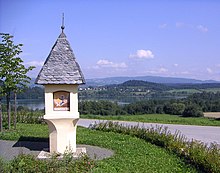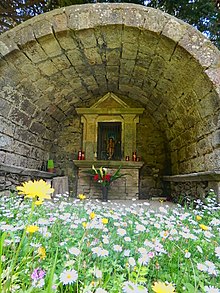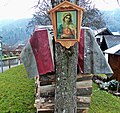Wayside shrine

A wayside shrine ( , from old German stock / stoc , 'something in the height') in Hesse as Heiligenstock , in Austria and Bavaria also known as Marterl or Marter , Materle , Materla , Wegstock or Kreuz , in Switzerland as Helgenstöckli , as a small religious monument , is a pillar made of wood or stone, which usually stands on paths and carries a sculptural or painted votive or devotional image (usually the image of a saint, a scene with saints or the crucified Christ).
In the Alpine countries the establishment and maintenance of wayside shrines and martyrs is a widespread form of popular piety . The motivation is similar to that of the crossroads : as an impetus for prayer on the way, as a token of gratitude for overcoming dangers or epidemics and as a reminder of accidents.
Wayside shrines are made of wood, stone or masonry. Often flowers are laid down with them or candles are burned. Another name for a wayside shrine is a broad pillar or a prayer column .
Demarcation
Newer wayside shrines are pillars or pillars in the narrower sense , which are crowned by an attachment with pictorial representations (painting or relief) or a figure or group of figures. In 1970, the Viennese Franz Hula distinguished them from light columns (see also: Lantern (architecture) ), meaning columns or pillars without pictorial representations, broad pillars or figures of saints on a pedestal that either stand on church cemeteries or outside of them.
The medieval free-standing funeral lamp was used to illuminate the cemetery in order to commemorate the dead. In the course of time, according to Hula, smaller lamps for the dead emerged from them, which were placed, for example, at plague cemeteries outside the localities. Hula had described these smaller versions as a kind of wayside shrine in 1948 , before he recommended the term light stick for them in 1970 .
If in doubt, Hula suggests using the terms niche or tabernacle pillar if it is not clear whether it is a light or a wayside shrine. This distinction is made more difficult by the fact that mixed forms sometimes occur.
While the hula ascribes a collective meaning to the death lights and light sticks, since the light was intended for all buried people, wayside shrines are occasionally dedicated to individuals - they are supposed to remind of a victim or an accident that has survived unscathed ( votive picture ), which is why they are often at intersections of streets and paths . You can also find them on old pilgrimage routes such as the Via Sacra from Vienna to Mariazell . Wayside shrines and field crosses are usually marked on maps (hiking maps) and form important landmarks. When relocating roads, they are often shifted to the new course of the road with considerable effort.
In addition to accidents, wayside shrines can also be a reminder of crimes, such as the murder column for Bishop Konrad von Querfurt near Würzburg Cathedral , which, according to Hula, is a stick of light.
Hula's work on funerary lamps and wayside shrines in Austria from 1948 has not yet been updated. However, it has meanwhile been criticized that Hula's systematics and theory for the creation of wayside shrines from lights for the dead only apply to wayside shrines in the Alpine region, especially in Austria, and cannot be transferred to other landscapes such as Franconia .
Types
Guys after hula
Hula divided wayside shrines in 1948 according to the following system, which also included the column of death known as the "French type".
- The tabernacle pillar , which has the largest number of specimens and has been around since the 14th century, consists of a base on which an almost always square, often beveled shaft sits. Gothic tabernacle pillars sometimes have an artfully twisted shaft on which the tabernacle usually protrudes and sits, which can be hollow and open on one or more sides. These tabernacles are used to hold candles or figures of saints and are often figuratively decorated. Massive tabernacles adorned with relief representations have appeared since the Renaissance . On the tabernacle sits the helmet, which can take on different shapes (pyramid, saddle helmet, onion helmet) and whose shape was adopted from the church tower depending on the zeitgeist. The helmet is crowned by a cross, which was originally mostly made of stone, more rarely made of metal.
- Tyrol and Carinthia have developed a different type of tabernacle pillar, which is referred to as the Alpine type . They are somewhat massive, squat tabernacle pillars with a very high and large pointed roof made of straw, bricks or shingles. There are no figurative representations, but paintings, which can be attributed to Italian influences.
- In the Renaissance, the brick pillar appeared, which is intended on the front to accommodate figures of saints or pictures. The wider pillars are sometimes in the shape of a small chapel. Broad pillars occur mainly in the Wachau .
- The figural wayside shrine has appeared above all since the Baroque period . The base and shaft were taken from the tabernacle shrine, but the tabernacle was replaced by free sculptures of saints. Later, the shafts were designed as columns decorated in baroque style or the larger sculptures were placed directly on a low base. Special forms are the baroque plague columns and Marian columns . The figures used were Christ , Mary , the Holy Trinity , St. Nepomuk or various patrons.
Tabernacle pillars in Pulkau , Lower Austria
Alpine freedom column , also known as Weißmarter , in St. Georgenberg , Tyrol
Broad pillar in Lasberg , Upper Austria
Figural wayside shrine with a group of baroque vacationers in Ernstbrunn , Lower Austria
Broad pillar in Kleinmünchen
Tabernacle shrine in Nöchling , Lower Austria
Mary's shrine in Mönichwald, Styria , erected in 1974 (according to the reverse).
Figural tabernacle wayside shrine for St. Johannes Nepomuk on the main square of Sillian in East Tyrol ( Austria ).
St. George's wayside shrine in the Rhine area of Koblenz , Rhineland-Palatinate
Column shrine from 1738 next to the Catholic parish church St. Johannes Baptist in Seulingen , Untereichsfeld
Plague shrine in Langkampfen , Tyrol
Picture and poem on the "Leixnertaferl" near Neustadt an der Donau in Lower Bavaria
Wayside shrine in Trier , Rhineland-Palatinate , 1673
According to the guide to the small and landmarks database


Categories of wayside shrines
The guideline for the small and field monument database for Lower Austria and Salzburg adopted some of Hula's approaches from 1970 and structured the category shrines as follows:
- Pillar and column shrines are divided into light and shrines according to their function. They can appear in various forms, as tabernacle columns and pillars, niche and relief block pillars, arbor pillars, block pillars and pillars, relief table pillar, box pillar, niche block pillar, statue pillar and others. The guide contains example sketches on two pages.
- Broad pillars are bricked and usually have a rectangular floor plan and a gable-shaped roof.
- Chapel shrines, also known as holy houses , are similar to broad pillars, but do not have a step and can be entered by one person for the purpose of decorating. In contrast to the chapel , however, they are not intended for general entry and prayer.
- Picture trees are based on natural origin and carry one or more pictures with religious motifs.
- Copies of the subcategory rock niches also contain images and inscriptions on rocks or in rock niches.
- Pole pictures are slim wooden poles with a picture (box) attached.
Torture and torture
Separately from the category of wayside shrines, this guide covers the category of martyrs , columns, crosses and, more rarely, tablets on trees or rocks on which accidents are described or depicted and which often ask the viewer for a prayer. They are given a mental connection to the atonement cross . The guide recommends, however, not to include objects in this category that have only been given such importance by tradition. They are to be categorized according to their external shape.
The term shrine or torture is often used the case for the shrines and other monuments hallway. The Austrian / South German designation is derived from the word Marter / Märtyrer ( ancient Greek μάρτυς mártys "witness", "blood witness").
Marterl or torture have been known since the 15th century, but were banned during the Enlightenment . Marterls have been set up since the late 19th century, for example to remind people of traffic accidents.
Ladle
In the Eifel in particular, the term “ ladle ” is used to refer to tabernacle shrines , which belong to the basalt crosses and were used to place the pyxix with the consecrated host during processions. They are not shrines in the narrower sense, because the niche was normally empty and figures have only been placed in it more recently, when the original use was long forgotten. Some of these small monuments date from the late Middle Ages , but mostly from the early modern period . In Thuringia there in Arnstadt high seven-foot medieval shrine with two niches that after one, but only at Ludwig Bechstein tangible forecast a giant as a tablespoon serving (giant spoon) .
distribution
In Germany, these small religious monuments can be found mainly in Franconia , in the Catholic parts of Baden , Swabia , in the Alpine countries and the Catholic areas of the historic Eichsfeld , in the Fulda area (with the Rhön ), the Münsterland , the Rhineland and Upper Lusatia . In Austria, wayside shrines are found in the Alpine region and in great density in the Weinviertel , Mühlviertel and Waldviertel . There are similar small monuments in South Bohemia and South Moravia as well as in other former countries of the Danube Monarchy . As evidence of German settlement history in the Ofner Bergland or in the Pilis Mountains near Budapest, numerous wayside shrines have been preserved, among others in the municipality of Sankt Iwan bei Ofen (Pilisszentiván). In the south of Austria, especially in Carinthia, there are many wayside shrines that served as signposts. The depiction of a saint shows the way to a church dedicated to this saint.
Wayside shrines (peirónes) are also common in some regions of Spain and Portugal , e.g. B. in Aragon .
literature
- Günter Besserer, Günter Schifferdecker: wayside shrines, crosses and Madonnas. Stone witnesses of popular piety . Edited by the local and cultural association Lauda, Lauda o. J. [around 1984]
- Michaela Brandstetter - Köran: wayside shrines in the Taubertal around Bad Mergentheim, Weikersheim and Creglingen , Bergatreute 2000
- Josef Dünninger , Karl Treutwein : wayside shrines in Franconia. Thorbecke, Konstanz 1960 (= Thorbecke Art Library. , Volume 9).
- Franz Hula: The lamps for the dead and wayside shrines in Austria - an insight into their origins, their essence and their stylistic development . Poech, Vienna 1948, OBV .
- Franz Hula: Medieval cult marks. The lights of the dead of Europe. Karner, Schalenstein u. Cemetery soculus . Self-published, Vienna 1970, pp. 6-9 ( excerpt ).
- Bernhard Losch: Atonement and Remembrance. Stone crosses in Baden-Württemberg. An inventory . Published by the State Office for Folklore Stuttgart and the Württembergisches Landesmuseum Stuttgart, Stuttgart 1981
- Georg Jakob Meyer, Klaus Freckmann: Crosses and wayside shrines in the Eifel, on the Moselle and in the Hunsrück. In: Rheinisch-Westfälische Zeitschrift für Volkskunde. Volume XXIII, 1977, pp. 226-278.
- Friedrich Zoepfl: Bildstock , in: Reallexikon zur Deutschen Kunstgeschichte , Vol. 2, 1940, Col. 695–707.
- Category 1520–1540 , in: Walpurga Oppeker, Hans Georg Mössner, Franz Stürmer: Guide to the small and field monument database for Lower Austria and Salzburg (Version 2/2012), pp. 1–85. Online version from October 23, 2018, published by the LEADER cooperation project "Signs of our cultural landscape" at www.kleindenkmal.at .
See also
Web links
- More Wiktionary entries: altarpiece floor , Betsäule , wide pillars , floor shrine , Freiungssäule , Chapel shrine , Marian column , plague column , bar screen , Tabernacle , Tabernakelbildstock , Tabernakelpfeiler , Wegkreuz
- Atonement crosses and killing stones - information on wayside shrines and their locations in Germany (private site)
- Walpurga Oppeker, Hans Georg Mössner, Franz Stürmer: Guide to the small and field monument database for Lower Austria and Salzburg (Version 2/2012), pp. 1-85 . Online version of October 23, 2018, published by the LEADER cooperation project "Signs of ours Cultural landscape ", therein:
- Explanation of the categories of small monuments (PDF)
- Saints and their attributes as well as religious symbolism - especially for small monuments (PDF)
- Technical terms in architecture - especially for small monuments (PDF)
- Identification key for the categories of small monuments (PDF)
- Further reading (PDF)
- Wayside shrine portal of the Rhön
Individual evidence
- ↑ Heiligenstock www.frankfurt.de, accessed on March 3, 2020
- ^ Friedrich Kluge , Alfred Götze : Etymological dictionary of the German language . 20th ed., Ed. by Walther Mitzka , De Gruyter, Berlin / New York 1967; Reprint (“21st unchanged edition”) ibid 1975, ISBN 3-11-005709-3 , p. 752 ( stock ).
- ↑ Heiligenstock from the year 1516 www.kunst-im-oefflichen-raum-frankfurt.de. accessed on January 17, 2015
- ↑ New Helgenstöckli in Retschwil (PDF; 1.1MB) www.pfarreihitzkirch.ch, accessed on January 17, 2015
- ↑ Swiss Lexicon. 7 volumes, Encyclios, Zurich 1945–1948, Volume 1, p. 1271.
- ↑ Hula: Lights for the Dead .
- ^ Josef Dünninger: wayside shrines in Franconia in: Bayerisches Jahrbuch für Volkskunde 4 , 1952, p. 32.
- ↑ Stefan Popp: wayside shrines in the northern district of Würzburg: inventory and mentality-historical studies on small religious monuments , dissertation, University of Würzburg, 2004, p. 43 ff.
- ↑ Oppeker / Mössner / Stürmer, Guide to the Small and Land Monument Database for Lower Austria and Salzburg (Version 2012/2), www.kleindenkmal.at , Category 1520–1540, accessed on October 23, 2018
- ↑ from: Das Kleindenkmal: Suggestions for the research, preservation and new construction of small monuments. In: Institute for Folk Culture and Working Group for Small and Land Monument Research (Ed.): Arbeitsblätter , Linz 1994.
- ^ Max Döllner : History of the development of the city of Neustadt an der Aisch up to 1933. Ph. CW Schmidt, Neustadt ad Aisch 1950. (New edition 1978 on the occasion of the 150th anniversary of the publishing house Ph. CW Schmidt Neustadt an der Aisch 1828-1978. ) S. XXXIX ( "White Torture" from 1518) and XXXX ("Red Torture" from 1488).
- ↑ Guide, p. 37
- ^ Kurt Müller-Veltin: Middle Rhine stone crosses from basalt lava, Neuss 1980, pp. 66–67.
Remarks
-
↑ Marterl, that; -s, - [n]; see. Pickerl (Bavarian and Austrian for a board with a picture and an inscription in memory of the accident victims, pillar with a niche for a crucifix or a picture of a saint ). - From: Duden - The German spelling . 25th edition. (CD-ROM edition). Mannheim 2009, ISBN 978-3-411-06828-9 . Web
- For further differentiation see: K. Gruber: Marterl and Taferl. In: Journal of the German Alpine Association / Journal of the German and (of the) Austrian Alpine Association , year 1888, (Volume XIX), pp. 129-136. (Online at ANNO ). .




























